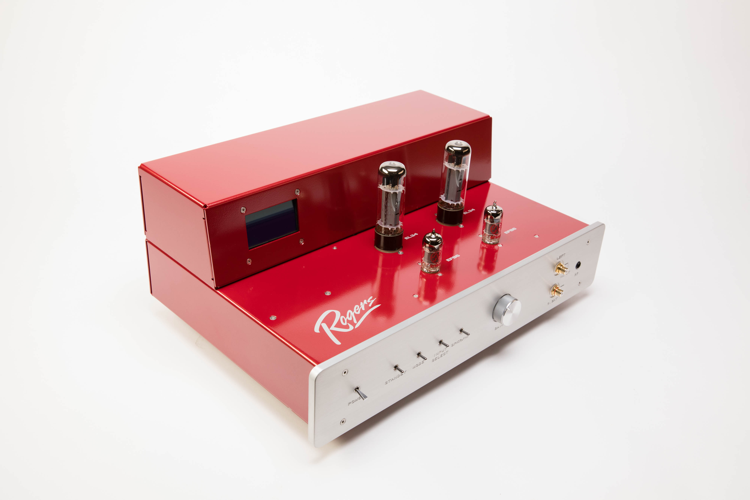
What I love most about this hi-end audio hobby is that it is absolutely captivating to hear great music on great equipment. It’s as simple as that! The Listening makes the whole world disappear for a brief few minutes. Even if I have heard the song a thousand or more times, a great amplifier, a transparent set of speakers, and a good source can bring thrills and fun to my life. The Rogers High Fidelity 65V-2 filled the bill.
I just came from listening to the Violent Femmes’s “Kiss Off” (Live) from their 1993 compilation disc Add It Up, and once again, I am awed by the blisteringly angstful and pent up sexual tension of Brian Ritchie’s bass playing. gave me toe tapping, hip gyrating thrills, and mind whizzing clarity into this old favorite. The same was also true for nearly everything else I listened to. What a fantastic little amplifier!
About Rogers High Fidelity
Haven’t heard of Rogers High Fidelity? Well, if you haven’t, don’t feel bad. Even though the Rogers 65V-1, the lower powered version of the 65V-2, has been thoroughly enjoyed by several reviewers from Stereophile and The Absolute Sound. This year Rogers also won both a Stereophile Recommended Component award and an Editor’s Choice Award from The Absolute Sound. Even os, the Rogers High Fidelity name might not be tip of the tongue, yet.
As an Audiogon forum user noted, however, they never seem to see much about Rogers amplifiers on the forums. It could just be that not many Rogers amplifiers owners want to part ways with their Rogers amplifiers. I don’t often see Audio Note or Eddie Current amplifiers for resale, either. I believe Jeff Day calls equipment like this, “exit level audio equipment”.
Roger Gibboni owns Rogers High Fidelity. He has a past in the aerospace industry, working on radar and satellite tracking. Rogers was actually a new company for me but I really enjoy the EL34 tubes, and they had an EL34 amplifier. My Mystere ia11 has brought me years of joy, so I had been looking to listen to more amplifiers with these tubes.
Rogers amplifiers are made in the United States, previously in New York but now out of North Adams, Massachusetts. They offer a lifetime transferable warranty on all equipment. They even run thermal testing on the equipment, putting it through stress tests well above normal everyday use. Gibboni not only wants you to pass on your love of music to your children, but also the equipment as well. It’s built to last!
Build Processes and Standards
I encourage you to read about the processes and standards the amplifiers are built too. These standards give him the confidence to offer a lifetime warranty. In fact, on his website he says, “Your kids will fight over these amps.” Here are some of the highlights:
- Analog sections of the amplifiers “utilize individual, discrete components – no chips!”
- All wiring is point-to-point.
- All wiring uses 18-gauge Military Standard 16878 Teflon coated, silver-plated, copper wire, which is used in mission-critical applications.
- The amplifiers meet Military Standard 2000 requirements, and all assembly technicians are trained and tested on these high standards.
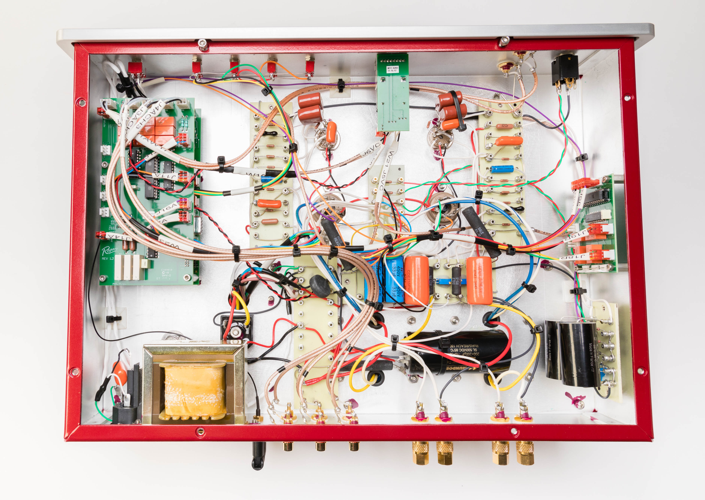
I asked Roger how his experience working to high spec and chain of custody standards in the aerospace industry has influenced his way of making amplifiers. He believes these standards give his amplifiers an edge on differing the detrimental effect of heat to electronics and designing and executing to extreme detail. This all adds up to his confidence in his products and is why he gives a lifetime warranty.
The 650V-2 Design
Now, moving on, here’s a little more about the design of the 65V-2 integrated amplifier. The 65V-2 is a newer amplifier in the Rogers High Fidelity audio lineup. Released in 2018, it is a more powerful and higher end version of the 65V-1. Both versions are single-ended Class A integrated amplifiers that can use either the EL-34, KT-88 or EF86 tubes.
Roger notes that he used the EF86 tube to get all of the gain in a single stage with a very short signal path for less phase distortion. The V-2 puts out 40 Watts (10 Watts @ 1% THD) while the V-1 puts out 20 Watts (5 Watts @ 1% THD). The V-2 uses a toroidal type power supply and separate low noise DC tube filament power supply. It also boasts a small LCD display to show selected and available settings. The display can be controlled manually with switches along the front of the amplifier or via an iPad/iPhone control application.
In my room, the 65V-2 was eye-catching. Unlike the flat black finish of the 65V-1, the 65V-2 has a beautiful DuPont high-gloss, gold flecked sintered red powder-coat finish. The red of the body alongside the silver of the billet aluminum engraved front panel really pops in a room.
More Good Stuff
While the looks may get your attention, there’s more good stuff built into the 65V-2. All five of the available gold-plated inputs, even the set on the front, are attached to the chassis and the binding posts are of very high quality. Made from billet copper and then gold plated. They make for a great connection that is easy to manage. Not to be overlooked, there is also a high-end ¼-inch headphone jack on the front of the amplifier that uses nearly all of the same pathways as the main amplifier. It does have different output transforms and dedicated wiring.
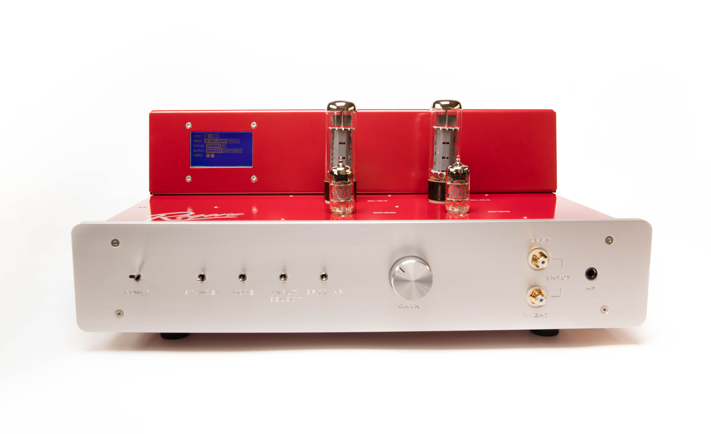
As you can see, there is a lot to talk about with the 65V-2. Oh, and lest I forget, the 65V-2 can run in both ultra-linear and triode mode. In short, the 65V-2 is a versatile, simple single-ended amplifier with modern features that can even work as a high-end headphone amplifier.
Well, we should get into the listening sessions now, shouldn’t we?
Listening Gear
I used a variety of equipment alongside the 65V-2, and each set up offered me a different perspective on the amplifier’s sound. For the analog front-end, I used my Rega-P3/24 with the Cardas tonearm wire upgrade, the SoundSmith Carmen V1 cartridge and an MMP3 V1 phono amplifier.
For digital I had the Orchard Audio PecanPi USB DAC (review here) and Schitt Audio Gungir multibit DAC, both connected via the WyWires USB cable. I used both the WyWires Platinum series Litz wire or MG Audio Planus III flat ribbon speaker cables. Interconnects were the Stager Solid Silver (review here).
For power I used the Vermouth Audio Reference AC cable (review here) from a dedicated power outlet. Finally, for speakers, I had a variety to choose from. The recently reviewed MayFly MF-201 speakers, the PMC TB2i speakers, and the Audio Note AN-K/LX speakers. I also used my own Teresonic A55 speakers with Lowther A55 drivers and the Acousta 90s with Lowther PM2A drivers.
Musical Selections
Now that the preamble of the associated gear is out of the way, let’s get on with the listening sessions. As for the musical selections, I tend to listen to a little bit of everything, but here is my list of recordings I always come back to when reviewing equipment:
Dead Can Dance’s – Towards the Within
Jennifer Warnes – Famous Blue Raincoat
Heifetz’s Tchaikovsky-Mendelssohn
Daft Punk – R.A.M.
As I stated previously, the 65V-2 took me on a journey, so keep that in mind as I relay my experiences with it to you.
Player Number 1
Player Number 1 or my first listening setup with the Rogers 65-V2 featured my PecanPi DAC as the front-end source. I had the KT88 tubes installed and in the ultra-linear mode with the WyWires speaker cables and my Lowther PM2A speakers in the Acousta 90 cabinet. The sound from the 65V-2 was exciting, fast, emotional and transparent. There were details in the extreme. The mid-range was exceptionally clear. Even the lower mid-range decayed in a very natural way. With crooners, sometimes being too close to the mic causes this throaty bloom in the lower mid-range, but now that close mic sound was there without bloom and sluggishness. Nor was it cold and lacking of sweetness that tubes will impart. Finally there was a very clear balance between transparency and speed and natural sounds.
Several friends noted that in some recordings, they heard new things they had previously not heard. The bass was powerful and balanced, all-be-it with the Lowther drivers, it might not have been as powerful as some folks would prefer. That was not an issue with the MayFly MF-201 speakers, though I prefer to hear timbre and harmonics over umph and thump, especially in my smaller listening room.
While there was so much working for me with this combination, there were two things that were not. First, there was a bit of a cap on the highs at the mic-air level. Though, this cap was only noticeable when played through the Lowther PM2A and Teresonic A55. With the Audio Note AN-K/LXs, Mayfly FM-201s or the PMC TB2is this was much less apparent. Secondly, even with all of the clarity in the mid-range, speed, and details in the highs, the music just had an edge to it that just didn’t settle right. It made for short listening sessions and lower volumes than I would have liked.
Minor Adjustments
Over several weeks of listening, I rotated between the KT88 and EL34 tubes, but I found myself more drawn to the EL34 tubes in ultra-linear mode. While I enjoyed the amplifier, it didn’t have as much body and lower mid-range as, for example, an Audio Note OTO. Fast? Yes. Detailed? No doubt. Transparent? It was as transparent as glass. Even the sound stage could grow or shrink or have a bit more 3D depth in trido mode versus ultra-linear. But, the amplifier just wasn’t settling for me and my listening sessions were short.
Initially I tried swapping speaker cables. I know the WyWires Litz cables tend to sound more exciting and lively than my MG Audio Planar III ribbon cables. There’s just a bit more smoothness, liquidness, at the very top end. The MG Audio cables did make a difference, but it wasn’t enough.
Player 2
This got me thinking, maybe it was time to listen to the 65V-2 with my Rega P3/24 as the source. I knew the sound would not be as detailed or coherent as it was with my PecanPi DAC. It might be controversial to say, but a good $500 DAC like the Orchard Audio PecanPi does a lot more things right than a $3,000 analog setup. I had played the P3 through my Lowther drivers enough times to know that the flaws in the Carmen cartridge and turntable would be exposed. I knew this would be the case even more with the transparency of the 65V-2 amplifier and the PM2A drivers. Even so, I had to know if that edge was still there with an analog source.
Well, guess what, it wasn’t there. In fact, the sound from the analog system was very good. It was natural and tonal but fast, compelling and emotional. Yes, it was still flawed. It wasn’t as detailed as with the DAC, the staging wasn’t as coherent, and the bass wobbled at times. All issues with the source, not the amplifier. Even so it was good enough to have me pulling out my favorite cuts to listen to, Sigur Rós’ Takk, Jeff Buckley’s Hallelujah, and Ratatat’s LP3. So much goodness was coming out of my speakers, I didn’t want to go back to digital.
And then, player three entered.
Player 3
Over this time I had been talking with a friend about DACs, and eventually he dropped off his Schitt Gungir multibit DAC. He claimed it was the analog of digital sound and offered what vinyl lovers crave but in perfect digital form. Call me skeptical, because I was.
I ended up not giving the DAC back. This is what I had needed to pair with the 65V-2. The edge was gone, just like it had been when sourced off of a pure analog front-end. With the PM2A speakers in the system, the Mullard EL34 tube with about an hour and half to warm up the MG Audio speaker cables, the synergy of it all just worked out wonderfully. I could finally push the volume up a bit more and listen for several hours at a time.
The music could be harsh and stern or smooth and sultry. Horns could be in my face and strings could be straining. Some of my favorite but poorly recorded metal albums suffered from even more exposure, but the detail made other poorly recorded gems like The Unicorn’s Who Will Cut Our Hair When We’re Gone, even more interesting to listen to. The deep rough sound of Leonard Cohen’s voice was finally just right, not unnaturally muffled and the power from Lisa Gerrard could penetrate!
Depending on the recording, I was either listening right at the edge of the microphone diaphragm or seated back in staging with a grand hall filling my room. The drums from Dead Can Dance’s Towards the Within were deep, powerful, and tonal. I could hear the resonance and strike on the skins. I was in the room with Gareth Liddiard of The Drones as they performed Sixteen Straws, of Gala Mill. The guitar strings were buzzing when played sloppy and rough. It was emotional and moving.
Conclusions
What I had been experiencing initially with the 65V-2 was not the flaws of the amplifier, but rather the edginess of the of the PecanPi DAC. Which, was not apparent on less transparent equipment. It’s still a great DAC for the money, and I highly recommend it. Like my Rega P3, however, it is not immune to the exposure that high end equipment can bring to it.
One might ask, doesn’t this just mean the 65V-2 is pickier to pair other gear with? That’s possible. It is a wide bandwidth amplifier, up to about 50KHz. When matched with exemplary mid-range drivers like the PM2A, it is the most truthful sounding music I have heard in my room. Sometimes that means horns are irritating, or that I hear mistakes in the craftsmanship of the recording.
I remember listening to Miles Davis’ Porgy & Bess at Jack Roberts’ house on his Teresonic Ingenium XR speakers with the Lowther DX4 drivers. I know there was a Shindo preamp in the mix but the rest of the gear escapes me now. This was the most real recorded sound I had heard. The Rogers 65V-2 is my next, and affordable, step in that ‘real’ direction.
My Decision
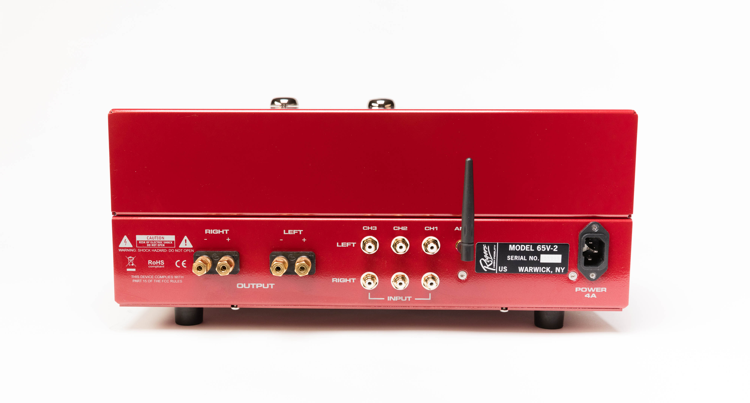
There is a fair amount to cover. I will do my best to keep things cogent, but this amplifier did take me on a bit of a journey. The very short story is that I decided this amplifier was an “exit component” for me. I purchased it even before the review period was over. That doesn’t mean that I won’t review other amplifiers because I will. It simply means that this is one I want to keep. So let me go over why I made this decision.
First of all, the price point of $5,250 (at the time of this review) puts this amplifier in competition with many other very good amplifiers, notably the Audio Note OTO series, another “exit level” component that I have been wanting for a long time.
Second, I’ve recently started to build my own speaker cabinets experimenting with everything from bass-reflex designs to Voigt Horns and more. I wanted a flexible amplifier that I could tweak in a variety of ways as I listen to each new cabinet I build for my Lowther PM2A drivers. Since the 65V-2 can run in both ultra-linear and triode mode I can adjust the mid-range to my needs. The auto-biasing of the EL34 and TK88 tubes gives me a variety of tubes to try out. Plus the tubes themselves are very easy to access, which makes tube rolling a sinch.
Not everyone will share these concerns, but the 65V-2 isn’t suffering from the “jack of all trades, master of none” syndrome. It is an excellent amplifier for high-efficiency drivers and allows the owner to experiment and tweak the sound to their taste at a moderate cost. It isn’t like changing out 300B or 211 tubes.
The 65V-2 does come with either a choice of Mullard EL34 or Golden Lion KT88 tubes, or I’m sure both, if you want. For those interested, I will have a follow up on the 65V-2 with a slew of different tubes. This includes, JJ EL34s, (newer) Winged-C EL34, both Burxelles and Sittard EL34 tubes, KT88 Winged-C, gold pinned JJ EF806 and Blackburn, Ediswan and Sittard EF86 tubes.
The Headphone Amp
“Wait, wait, you didn’t talk about the headphone amp!” I hear you, so let’s do that now.
I couldn’t find out much about the headphone part of the amplifier in the specs provided on the Rogers website, so I asked Roger about that. He said the headphone amplifier is basically the same as the main amplifier. It just uses custom output transformers and dedicated wiring, but basically the same gear. I plugged in my older Audeze LCD-2 headphones and a new Audio Note Litz headphone cable (review coming). Again, I had to go on a bit of a journey.
At least with the Mullard EL34 tubes, the sound was full, with great staging that extended outside my headspace. The bass was full but not snappy, and the high-end was smooth making for easy, long sessions. It may be a bit too smooth, but I have to remember that the LCD-2s aren’t Lowthers.
I started by listening to the headphones with the amplifier in ultra-linear mode. And while there was a lot right, there was just something wrong with male vocals and other sounds in the range. They were muffled, and sounded held back. There seemed to be a dip in that frequency range that I cannot explain. It is why I asked Roger if the headphone was the same as the main speaker amp. This muffled lower mid-range is not apparent at all when listening via any of the speakers I tried. Alas, ultra-linear mode just didn’t seem to pair well with the LCD-2. The trido mode, however, is where it is at!
I’ve heard my LCD-2s on I’d say a fair amount of headphone amplifiers. Some of these amplifiers were very expensive like the Pass Labs HPA-1, and a slew of other top notch amplifiers at shows. By far the best I’ve heard the LCD-2 headphones sound was paired with was an Eddie Current 2A3 amplifier at a Southern California headphone meet up, years ago. That is my standard. That amplifier made the LCD-2 move with real force, life and clarity.
Does the 65V-2 headphone amp live up to that? Unfortunately no, but it is still better than many others I’ve heard. The music is rich without being slow and detailed without being extreme. While I might have preferred a bit more aggressive highs, the reality is the smoother highs do allow me to listen to the headphone amplifier for hours on end while I work. And it is very enjoyable.
The headphone amplifier is a real treat to have with the amplifier. In fact, I even find myself listening to it on its own, even when I could listen to my large speakers instead. I think it works very well as a headphone amplifier, at least in triode mode when paired with the LCD-2s.
Is It Perfect? Well Almost
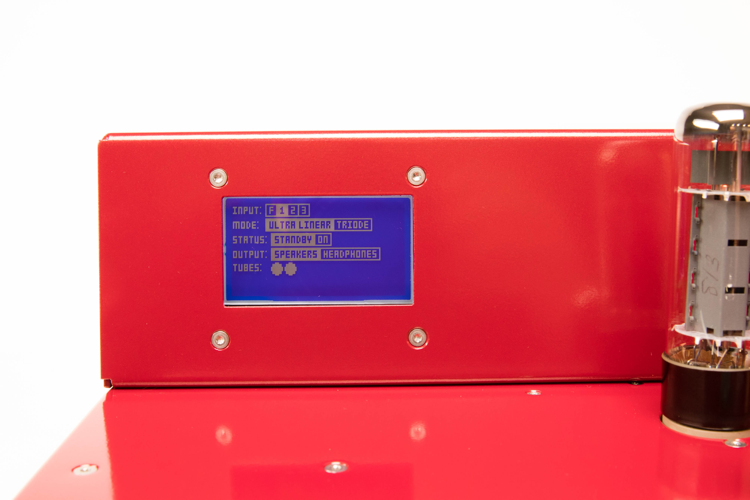
I don’t know Roger Gibboni that well. From the conversations I’ve had with him and more importantly, the YouTube videos I found of him explaining amplifier designs at what appeared to be a local meetup (remember, we used to have those), Roger strikes me as a no nonsense engineer who knows his stuff. I’m not an electrical engineer, and it would be impossible for me to critique Roger’s design or tube choices. I know that I like what I hear, and I take him at his word about his work because he does put his ideas and thoughts out there for more other engineers to examine.
So finally, is the amplifier perfect? Probably not. Is any amplifier perfect? Probably not, otherwise there wouldn’t be so damn many to choose from! But the 65V-2 satiates my desires for transparency, detail, speed and tonality. It does a lot right when paired with synergistic components. Enough for me to make it my own “exit level” component.
I do have a solid critique on the user interface, though. The amplifier is beautiful, the Matador Gold color pops, and the switches seem like they are right out of an airliner cockpit. However, the order of the LCD display of settings is not the same as the order of the switches on the front aluminum panel.
That means I have to remember that even though input is the first item in the LCD list, it is the third switch in the left to right order after the power switch. Maybe I’m sensitive to this user experience as a web and mobile applications developer, but this irks me. Yes, I got used to it, and yes, I can obviously live with it. But I hope one day Roger will reorder the LCD list and then send me a way to flash the bios of that thing to reflect the order of the actual switches on the panel.
One Last Thing
Wait, you mean there is more?
Yes, the 65V-1 and 65V-2 both come with an iPhone and iPad application that connects via Bluetooth to the amplifier and gives you a power meter read out (noted by folks at Stereophile as being cool but maybe not 100% accurate). More importantly to those of us sitting down in our comfy listening chairs, it’s a volume control.
Well, I’ve heard the app is great, but I have an Android phone so I’m not able to test it. There, that was cogent, wasn’t it!

I’m curious why you did not include your Devore, Super 9’s? Have they fallen out of favor with your listening tastes? I would guess they wou;d work very well with the Rogers amp. Thanks, Lyle
Hi, I’m curious why your Devore, Super 9’s weren’t included? Have they fallen out of favor with your listening habits? In my thinking the Super 9’s would be quite compatible with the Super 9’s. Thanks, Lyle
Hi Lyle,
Unfortunately I have not owned a pair of Devore Super 9s, or had a set in for review. I wouldn’t mind, but I have not. You may have me confused with Jack. I’ll take that as a compliment.
Devore, if you are listening, I’d love to review a pair of the 0/93 or 0/96. I think they would be great to compare to the Lowther PM2A drivers in a similar cabinet.